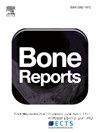Zoledronate interrupts pre-osteoclast-induced angiogenesis via SDF-1/CXCR4 pathway
IF 2.6
Q3 ENDOCRINOLOGY & METABOLISM
引用次数: 0
Abstract
Introduction
In this study, we tested the hypothesis that pre-osteoclast signaling is key in triggering post-traumatic angiogenesis in alveolar bone via the SDF-1/CXCR4 pathway. Interruption of osteoclast differentiation through zoledronate (Zol) disrupts the crosstalk between pre-osteoclasts and endothelial cells, hindering the initial angiogenic reaction following dental trauma. This disruption could therefore play a role in the pathogenesis of medication-related osteonecrosis of the jaw (MRONJ).
Methods
The effect of zoledronate on the expression of SDF1 was tested in pre-osteoclasts (POC) in vitro. Then, we tested the effect of pre-osteoclast conditioned medium on HUVEC cell differentiation, migration, tube-formation, and CXCR4 expression and activity in-vitro. Lastly, we quantified the effect of zoledronate treatment on post-traumatic vascular perfusion of alveolar bone, using microCT-angiography and immunohistochemistry.
Results
SDF-1 mRNA expression decreased in Zol-treated POCs (p = 0.02). Flow-Cytometry analysis showed a decrease in CXCL-12+ (SDF-1α) expressing POCs with Zol treatment (p = 0.0058). On the other hand, CXCR4 mRNA expression was significantly inhibited in Zol-treated HUVECs (p = 0.0063). CXCR4 protein expression and activity showed a corresponding dose-dependent downregulation HUVEC surface treated with conditioned media from POC treated with Zol (p = 0.008 and 0.03, respectively). Similar inhibition was observed of HUVEC migration (p = 0.0012), and tube formation (p < 0.0001), effects that were reversed with SDF-1. Finally, there was a significant reduction of CD31+ HUVECs in Alveolar bone of Zol-treated rats (p = 0.0071), confirmed by significantly lower percentage of blood vessel volume (p = 0.026), and marginally lower vessel number (p = 0.062) in the alveolar bone.
Conclusion
Pre-osteoclasts play a crucial role in the initial angiogenic response in alveolar bone following dental extraction. Disruption of this process may be a predisposing factor to osteonecrosis.
唑来膦酸钠通过 SDF-1/CXCR4 通路阻断破骨细胞前期诱导的血管生成
引言在这项研究中,我们检验了一种假设,即前破骨细胞信号传导是通过SDF-1/CXCR4通路触发牙槽骨创伤后血管生成的关键。通过唑来膦酸盐(Zoledronate,Zol)中断破骨细胞分化会破坏前破骨细胞和内皮细胞之间的串联,从而阻碍牙外伤后的初始血管生成反应。方法在体外测试唑来膦酸钠对破骨细胞前期(POC)中 SDF1 表达的影响。然后,我们在体外测试了前破骨细胞条件培养基对 HUVEC 细胞分化、迁移、管形成以及 CXCR4 表达和活性的影响。最后,我们使用显微 CT 血管造影术和免疫组织化学方法量化了唑来膦酸钠治疗对创伤后牙槽骨血管灌注的影响。流式细胞术分析表明,经 Zol 处理后,表达 CXCL-12+ (SDF-1α)的 POCs 减少(p = 0.0058)。另一方面,Zol 处理的 HUVECs 中 CXCR4 mRNA 的表达受到显著抑制(p = 0.0063)。用 Zol 处理的 POC 条件培养基处理的 HUVEC 表面,CXCR4 蛋白表达和活性也出现了相应剂量依赖性的下调(p = 0.008 和 0.03,分别为 0.008 和 0.03)。对 HUVEC 迁移(p = 0.0012)和管形成(p < 0.0001)也观察到类似的抑制作用,这些作用在 SDF-1 的作用下被逆转。最后,经 Zol 处理的大鼠牙槽骨中 CD31+ HUVECs 明显减少(p = 0.0071),牙槽骨中血管体积百分比明显降低(p = 0.026),血管数量也略有减少(p = 0.062)。这一过程的破坏可能是骨坏死的诱发因素。
本文章由计算机程序翻译,如有差异,请以英文原文为准。
求助全文
约1分钟内获得全文
求助全文
来源期刊

Bone Reports
Medicine-Orthopedics and Sports Medicine
CiteScore
4.30
自引率
4.00%
发文量
444
审稿时长
57 days
期刊介绍:
Bone Reports is an interdisciplinary forum for the rapid publication of Original Research Articles and Case Reports across basic, translational and clinical aspects of bone and mineral metabolism. The journal publishes papers that are scientifically sound, with the peer review process focused principally on verifying sound methodologies, and correct data analysis and interpretation. We welcome studies either replicating or failing to replicate a previous study, and null findings. We fulfil a critical and current need to enhance research by publishing reproducibility studies and null findings.
 求助内容:
求助内容: 应助结果提醒方式:
应助结果提醒方式:


